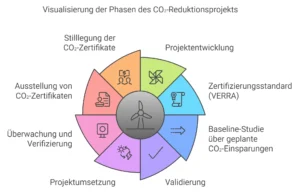The CO₂ footprint, also known as the CO₂ balance, refers to the amount of carbon dioxide (CO₂) and other greenhouse gases that are directly or indirectly emitted into the atmosphere by a person, organization, product, or activity. The CO₂ footprint is usually measured in tons of CO₂ equivalent (CO₂e) and is an important tool for quantifying and actively reducing the contribution to climate change. It includes the entire chain of greenhouse gas emissions – from raw material extraction to production, transportation, and disposal or recycling.
Components of the CO₂ Footprint
The CO₂ footprint can be divided into two categories:
1. Direct Emissions: These arise directly from activities, such as burning fossil fuels in vehicles or heating systems. These emissions are immediately measurable and thus easier to assign directly.
2. Indirect Emissions: These include all emissions that occur throughout the entire value chain of a product or service. This includes, for example, emissions that occur during the production of consumer goods or electricity generation. Indirect emissions are often covered by the so-called “ecological backpack” because they are not immediately visible but still account for a large portion of total emissions.
Calculation of the CO₂ Footprint
The CO₂ footprint can be calculated for various areas of life, including:
– Diet: Consuming foods like meat and dairy products results in higher emissions than plant-based products, as livestock farming causes high CO₂ and methane emissions.
– Transportation: The choice of transportation mode has a significant impact on one’s CO₂ footprint. Air travel, cars with combustion engines, and long commutes cause more emissions than public transportation or bicycles.
– Energy Consumption: The use of fossil fuels for electricity and heating significantly contributes to the CO₂ footprint. Switching to green electricity and energy-efficient appliances can reduce this footprint.
– Consumer Goods: The production and transport of consumer goods, particularly electronics and clothing, generate substantial emissions. A more sustainable consumption pattern, such as buying secondhand or extending the lifespan of products, helps reduce these emissions.
Reducing the CO₂ Footprint
There are many measures that individuals and organizations can implement to reduce their CO₂ footprint:
– Adjust Diet: Consume less meat and dairy, and focus more on regional and seasonal products.
– Increase Energy Efficiency: Save energy, switch to renewable energy, and choose energy-efficient household appliances.
– Conscious Consumption: Buy fewer, but longer-lasting products, and encourage repair and recycling.
– Shift Mobility: Where possible, switch to public transport, bicycles, or electric vehicles, and reduce air travel.
Importance of the CO₂ Footprint
The CO₂ footprint is a central concept in climate protection and helps make individual and corporate contributions to climate change visible. By quantifying emissions, targeted strategies for reduction can be developed. In a world that increasingly targets CO₂ neutrality, the CO₂ footprint provides an important foundation



